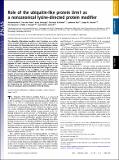Role of the ubiquitin-like protein Urm1 as a noncanonical lysine-directed protein modifier
Author(s)
Van der Veen, Annemarthe G.; Schorpp, Kenji; Schlieker, Christian; Buti, Ludovico; Damon, Jadyn Rose; Spooner, Eric; Ploegh, Hidde; Jentsch, Stefan; ... Show more Show less
DownloadVeen-2011-Feb-Role of the ubiquitin-like protein Urm1 as a noncanonical lysine-directed protein modifier.pdf (1.186Mb)
PUBLISHER_POLICY
Publisher Policy
Article is made available in accordance with the publisher's policy and may be subject to US copyright law. Please refer to the publisher's site for terms of use.
Terms of use
Metadata
Show full item recordAbstract
The ubiquitin (Ub)-related modifier Urm1 functions as a sulfur carrier in tRNA thiolation by means of a mechanism that requires the formation of a thiocarboxylate at the C-terminal glycine residue of Urm1. However, whether Urm1 plays an additional role as a Ub-like protein modifier remains unclear. Here, we show that Urm1 is conjugated to lysine residues of target proteins and that oxidative stress enhances protein urmylation in both Saccharomyces cerevisiae and mammalian cells. Similar to ubiquitylation, urmylation involves a thioester intermediate and results in the formation of a covalent peptide bond between Urm1 and its substrates. In contrast to modification by canonical Ub-like modifiers, however, conjugation of Urm1 involves a C-terminal thiocarboxylate of the modifier. We have confirmed that the peroxiredoxin Ahp1 is such a substrate in S. cerevisiae and found that Urm1 targets a specific lysine residue of Ahp1 in vivo. In addition, we have identified several unique substrates in mammalian cells and show that Urm1 targets at least two pathways on oxidant treatment. First, Urm1 is appended to lysine residues of three components that function in its own pathway (i.e., MOCS3, ATPBD3, and CTU2). Second, Urm1 is conjugated to the nucleocytoplasmic shuttling factor cellular apoptosis susceptibility protein. Thus, Urm1 has a conserved dual role by integrating the functions of prokaryotic sulfur carriers with those of eukaryotic protein modifiers of the Ub family.
Date issued
2011-02Department
Massachusetts Institute of Technology. Department of BiologyJournal
Proceedings of the National Academy of Sciences of the United States of America
Publisher
National Academy of Sciences
Citation
Van der Veen, Annemarthe G. et al. “Role of the Ubiquitin-like Protein Urm1 as a Noncanonical Lysine-directed Protein Modifier.” Proceedings of the National Academy of Sciences 108.5 (2011) : 1763 -1770. Copyright ©2011 by the National Academy of Sciences
Version: Final published version
ISSN
0027-8424
1091-6490